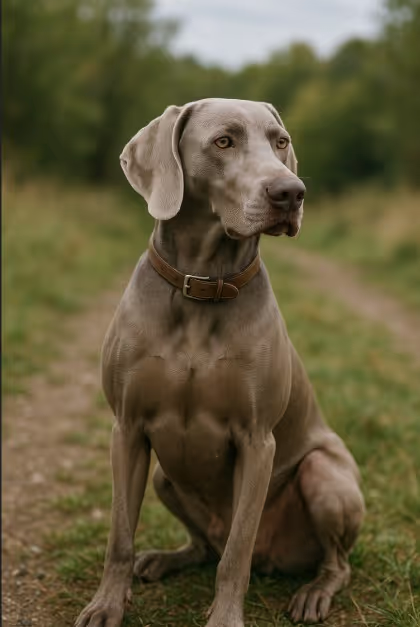The Weimaraner is a striking, high-energy breed known for its sleek silver-gray coat and boundless stamina. Bred in 19th-century Germany for big-game hunting, the “Gray Ghost” is a loyal, intelligent, and highly active dog. This breed thrives in rural or suburban homes with access to outdoor space, making it less suitable for apartment living. Weimaraners are known for forming strong bonds with their owners, often displaying separation anxiety if left alone too long. They're typically affectionate with children and friendly with other dogs when properly socialized, but their strong prey drive makes early training essential.

The Weimaraner originated in early 19th-century Weimar, Germany, where nobles sought a sleek, powerful hunting companion capable of pursuing boar, deer, and bear. The breed was strictly controlled and rarely found outside aristocratic circles. By the 1920s, the breed began to gain recognition in North America, thanks in part to Howard Knight, who imported the first Weimaraners to the U.S. Notable Weimaraners have even appeared in Hollywood and fine art photography by William Wegman, who famously dressed them in human clothes for surreal portraits.
The Weimaraner has a lean, athletic build, standing 23–27 inches tall and weighing between 55–90 pounds. Males are typically larger and more muscular. Their iconic coat ranges from silver to mouse-gray, often with a bluish tint. Eye color can be light amber, gray, or blue-gray, enhancing their ghostly appearance. Their gait is elegant and ground-covering, built for endurance. Weimaraners are often docked at the tail in countries where it's permitted, leaving a short, alert-looking tail around 2 inches long.
Despite their sleek coat, Weimaraners benefit from weekly grooming to remove dirt and reduce shedding. Use a rubber grooming mitt or soft-bristle brush once or twice per week. Bathe them every 4–6 weeks or as needed with a gentle hypoallergenic dog shampoo. Don’t neglect:

Weimaraners have exceptionally high energy levels and require at least 1.5 to 2 hours of vigorous exercise daily. Without proper physical and mental stimulation, they may become anxious and destructive.
These dogs were bred for all-day hunting, so a quick walk around the block won’t suffice.
Weimaraners are intelligent but independent, requiring early socialization and consistent training. They respond best to positive reinforcement but may challenge inexperienced owners.
Weimaraners thrive on high-protein, lean diets. Feed 2–3 cups daily, split between two meals to reduce the risk of bloat, a common and potentially fatal condition.
🛒 Recommended Brands: Orijen Large Breed, Wellness Core, Purina Pro Plan Sport
Yes, when raised with children or properly socialized. Their energy suits older, active kids. Supervise play to avoid knocking over toddlers.
Yes, they shed moderately year-round, especially in spring and fall. Weekly brushing helps.
They are not well-suited to apartments due to high energy needs and potential for noise when bored.
At least 90–120 minutes of intense physical activity. Ideal for runners or those with fenced yards.
Gastric torsion (bloat), hip dysplasia, and hypothyroidism are most common.